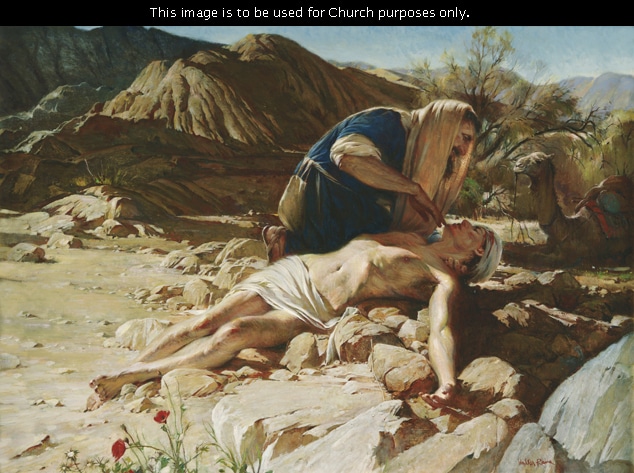Our Savior Jesus Christ has compassion for each one of us. We show compassion to others because it is the essence of His gospel. It’s what makes us Christian.
A few weeks ago, my toddler fell and got a typical toddler bonk on the head. He was hurt, afraid, bleeding, crying, “I hurt my eye, mama!” and I tried to assess the seriousness of his injury while consoling him.
For the first time in known memory, I experienced a moment of transfiguration. I held that little guy in my arms and felt his pain so viscerally that I wished with all of my might to take away his hurt and put it on myself instead. I paused to consider what I was feeling and the Spirit whispered to me, “This is compassion.” I was simultaneously fully conscious of his distress as overwhelmed with desires to alleviate it. I’d never felt anything like it.An experience like this is not exclusive to motherhood, of course. People in many circumstances find their hearts tuned to the distress of another and do what is in their power to give comfort.
A study of the life of Jesus Christ shows his acts of compassion in illustrative ways. This is the pre-Gethsemane Christ; he has not yet taken upon himself our sin and pain, but he is, time and time again, moved by compassion on behalf of the people. Prior to his suffering for all people, he quite literally suffered with them. He had compassion on blind men and restored their sight. He was moved with compassion and healed a man afflicted with leprosy. He had compassion on a widow, whose only son had died, and he raised the boy from the dead. He gives parables wherein a Good Samaritan has compassion for a wounded Jew, and a father for his prodigal son. His ultimate act of compassion was to actually take upon himself our pain and suffering in the Garden.
In all of these examples, compassion is present and judgment is not. In some ways, judgment and compassion seem to be close cousins: they both require us to assess the state of another person, evaluating what we observe. What we do next shows either mercy or malice. Where compassion seeks to understand, comfort, and mourn; judgment rebukes, assigns blame or volunteers advice. Judgment is the antithesis of compassion. Of course there are appropriate times and places to provide correction and offer solutions, but if a person’s wound is gaping and bleeding, judgment only adds insult to their injury.
While feeling the full force of the natural consequence of using his dresser drawers like a ladder, my son didn’t need to be reminded that it was against the family rules to climb on the furniture.
Jesus describes his feelings of compassion by saying that his “bowels are filled with mercy” for us. This description offers a sacred symbolism between the human digestive and procreative processes, and his sensation of being filled with urgent desires to alleviate our suffering. We feel our own compassion in our gut, sometimes our stomach sinking or twisting into knots when we relate to someone’s anguish.
To put on a cloak of compassion is to make ourselves vulnerable when we hear another express grief or pain. To truly empathize with them, we must refrain from trying to solve their problem and just listen, be present, and feel. It’s hard to be helpless, and it makes us feel a bit useless to hear of another’s pain –- that’s why we immediately start to offer advice. That should come later. Compassion is all about connection, not solution. To quote a favorite Brené Brown video on empathy, “rarely can a response make something better. What makes something better is connection.”
At the global level, I grieve over endless instances of violence and suffering. I mourn when local community prejudice hurts the real people I know, and I weep for my own fractured personal relationships. My broken heart cries out, “Where is the compassion?!”
Where is the compassion in that action? In those words?
In my recent personal life, I have felt the hammer of judgment come down with such force that I am still bruised from the blow. With feelings raw and emotional wounds fresh, my only wish was to be heard, understood, and given a safe space to be vulnerable. If we could all see inside each other, we would find that everyone is bleeding somewhere. “…in the quiet heart is hidden, sorrow that the eye can’t see.”
Recent events have had rippling effects in the lives of mainstream and marginalized members alike. How do we show compassion for them? The most challenging and important showing of compassion is to offer it to those with whom you do not agree nor understand.
Our Baptismal Covenants
The initial stage of compassion is to listen, comfort, mourn and suffer with. In this first expression, we take the perspective of the other person: put ourselves in their shoes, and try to feel what they are feeling. Second is to stay away from judging by recognizing the emotions in other people and communicating from a place of empathy. Next is to act out in loving ways – to be moved by compassion. And certainly not to inflict punishment. The waiting period between listening and acting will be different for every circumstance. If you need ideas about what you might do to act in compassion toward another, you could have them fill out this sheet — ILoveYou
Our Savior Jesus Christ has compassion for each one of us. We show compassion to others because it is the essence of His gospel. It’s what makes us Christian. The charity of Christ, his pure love, is a worthy goal for all.
When has someone showed you compassion when you needed it? When have you needed it and not received it? What experiences have you had in showing compassion to others?





5 Responses
This is an ideal compliment to the ETB lesson on a Christ centered life that I will be teaching this Sunday. Thanks for the lovely and loving narrative about living a truly Christian life.
At what point are you tapped so low you have nothing left to give? I am literally numb from fatigue, particularly at this time of year when everyone seems to say “gimme, gimme, gimme.” I’m not even sure how to get back to feeling anything.
Beautiful thoughts Violadiva! I love that you brought up that “Compassion is all about connection, not solution.” You expressed so perfectly, what true compassion is. Human connection is created when people feel heard, understood, and valued. The image of you feeling so deeply your sons pain and taking the time to help him feel your connection really shows the kind of compassion we need more in the church and the world.
[…] Where is the Compassion? […]
[…] Where is the Compassion? – Violadiva, Exponent 2014: “Such a Time as This,” Remarks at Stanford Convocation – […]